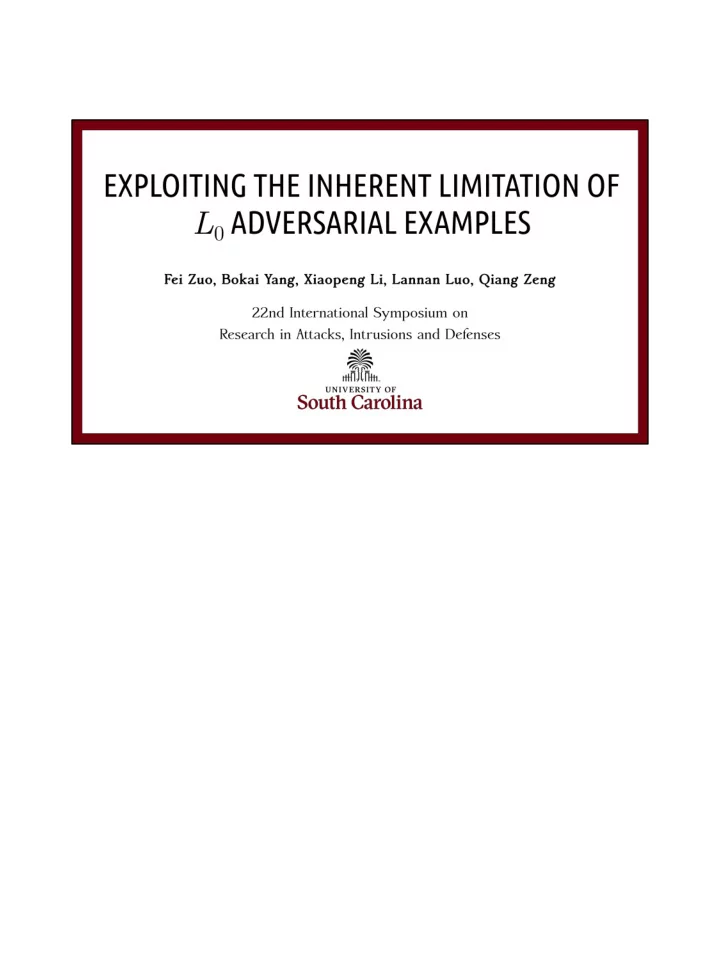

First we will introduce some necessary background. 2
For example, VGG16 can correctly classify the left image as giant panda. By contrast, after introducing some subtle noises, the adversarial image can fool the neural networks.
JSMA and CW-L0 are two leading L0 AE generation methods, we consider them both in our paper.
We show some image examples from CIFAR-10 after applying bit depth reduction. Given the different numbers of bit depth, the first row displays a benign image and its processed versions; the first row displays an AE generated by CW-L0 and its corresponding processed images; the second row displays an AE generated by JSMA and its corresponding processed images. As shown in the T able, processing the AEs generated by JSMA and CW-L0 with bit depth reduction cannot Significantly improve the classification accuracy of the target model.
8
In other words, those corrupted parts are mostly small and isolated regions. Here, we show some concrete adversarial samples generated by CW and JSMA algorithm. By exploiting the two characteristics, we build the defense and detection system based on a heuristic method and simple architecture to effectively thwart such kind of AE attacks.
We define a value as extreme if it is either smaller than an upper bound or larger than a lower bound. We present more empirical analysis about the range of extreme value. You can refer to our paper for more details. Here, we show some concrete cases. The leftmost image is an adversarial example genereted by JSMA algorithm. The following images are three masks which locate the pixels whose have extreme values in R, G, B channels, respectively.
If we can locate those the most likely adversarial pixels based on our heuristic, then we could use inpainting technique to restore these images. We show some examples here. The leftmost images are original images. Numerous parts are lost in the two corrupted images. After using inpainting technique, they can be well restored and visually recognisable.
Based on this straight forward strategy, we design a pre-processor to rectify the AEs. Please refer to our paper for more details of the proposed algorithm. Here we show some concrete examples. The first and third rows show the CW-L0 and JSMA attack applied to CIFAR-10 images, respectively. The second and fourth rows show the corresponding resulting images after restoring. One important insight is that the masks are unnecessary to be very accurate. In other words, in an advasarial image, even though one benign pixel is labeled as adversarial by mistake, the inpainting works very well for recovering it in a benign way. However, for an adversarial pixel, the inpainting effect usually is not what the AE attacker desires, since the maliciously perturbed pixels can hardly be recovered to the attacker-intended values.
We also can observe a similar result in MNIST datastet. Note the algorithm for gray images is very similar to the version for color images, but we only need to consider one channel rather than three.
Based on the inpainting-based pre-processor, next we will discuss our detector design. 14
For a benign image, before and after using our inpainting-based pre- processor, it tends to remain the same. However, for an L0 AE, before and after using our inpainting-based pre-processor, the image changes to some degree. We expect an automatic approach to capture the consistancies and the discrepancies. Fortunately, a Siamese network is capable of this task.
Identical here means they have the same configuration with the same parameters and weights. Parameter updating is mirrored across both subnetworks.
T ake the application in computer vision as an example, each subnetwork takes one of the two input images. The last layers of the two subnetworks are then fed to a contrastive loss function , which calculates the similarity between the two images.
For example, Siamese neural network can successfully assert these two images are both tigers. It also can correctly state that a wolf is different from a tiger. Similarly, Siamese neural network can successfully detect whether two hand- written digits are different or not. If the discrepancy between two images are large enough, we consider the input image as an AE.
Finally, we also consider the scenario of attaptive attacks. T o this end, we assume there exists an adversary who knows the details of our detector and will try to adapt the attacks accordingly. 21
Recommend
More recommend